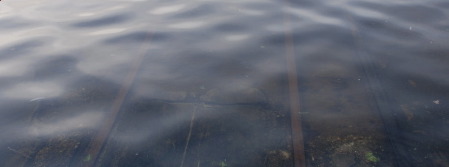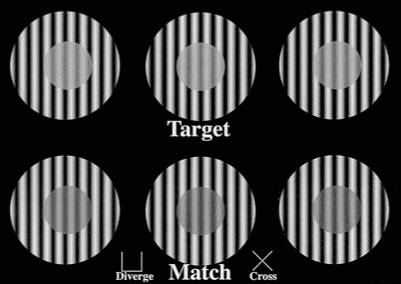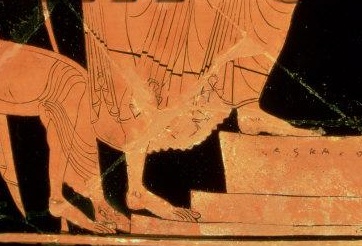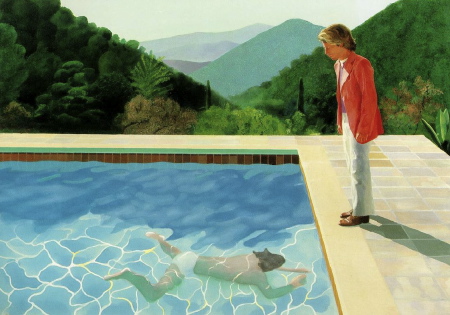
Painting From Life vs. From Photos

What is behind the illusion of transparency? How can artists make use of the effect?
I noticed the illusion of transparency in this photograph and it reminded me that the question of how we perceive transparent things is a hot topic in visual science.

Scientists use stimuli like those below to study the question. The consensus is that the visual system will make an interpretation of transparency when it detects two independent types of forms in the same place. Gratings like those below are useful in this type of research because the repeating patterns construct a sense of a continuous surface that can be seen through. The repeating patterns of the waves in the photo above produce the required effect nicely.

My colleague Robert Shapley of NYU pointed out to me that artists in ancient times used this same principle of repeating patterns to create the illusion of transparency. In this ancient Greek vase, the cloth appears transparent (perhaps translucent is a better word.) The effect is constructed by repeating patterns of the folds of the cloth, against which one can see the contour of the leg, for example.

Transparency through pattern as a technique for creating illusion should hold a lot of potential for contemporary artists, but it has to be done properly to create the effect. Here is an example from David Hockney that, despite a lot of cues, produces a only a weak transparency effect. We can recognize a pool filled with water, but the figure seems more entangled in the white reflections on the surface than submerged under them. The bluish cast and lower contrast of the figure are not in themselves particularly compelling in creating the transparency illusion. Perhaps that was Hockney’s intention; I think the light lines in the water are patterns of sunlight reflecting off the bottom of the pool and the figure, not the surface of the water. If so it is not surprising that these lines “break” a transparency effect. By using a more convincing repeating surface pattern for the water, he could have created a stronger illusion of transparency if he wanted to.

Have you ever created transparency effects using repeating patterns like the water ripples in the first photo or the cloth folds on the Greek vase as the primary transparency cue?

What a neat explanation for the beauty of the flowing cloth of the antique pictures!
So far, I have thought largely about reflections – Richard Estes’ in cityscapes or that of trees in lakes. Are transparency effects more interesting, more mysterious?
The picture of Hockney jars me because of the contrast of straight and curvy lines.
We need another category for methods across disciplines, here for the transparency effect.
I was at a lake yesterday and I looked at the water with this post in mide. I saw those bright lines that Hockney painted, they are light focused by the waves onto the bottom of the lake. There were also shadows of the waves on the bottom. Then there were reflections on the surface, different depending on the angle. Hockney seems to have left out or simplified a good deal of this.
Karl,
I don’t understand the grating patterns. Is the grating supposed to be the transparent element in front, or the background behind? The text implies the former, but it looks to me more like the latter. By the way, I have an example of an image with a grating in the background, I’ll post it later.
One problem with the Hockney is the bright caustic lines are continuous from the pool bottom to the swimmer’s back, as if Hockney thought they were on the water surface. Maybe that’s why they look more like something physical entangling the swimmer. Also, they’re too bright and narrow to look real.
Karl, my understanding of the illusion of transparency is that there are 2 possible components, shape and color.
With color, you read transparency as a visual mixture between the color of the transparent object and the color of what’s behind it. The more transparent the foreground object, the more the color of what’s behind it dominates.
As far as shape, I think the issue of repeating pattern is less important than the expectation of continuity. You could achieve the same effect with a city skyline in the background as with a repeat pattern in this regard. Repeat pattern is just one way to set up expected continuity.
The most convincing transparency illusions, I think, are achieved when you present a background that is only partially covered by a transparent object. The “Target Match” diagram above is a good example, showing a lighter (above) and darker (below) disc, getting progressively more transparent from left to right. It would be even better if it were in color, and there was a hue difference between discs and stripes.
For me neither the Greek vase nor the Hockney painting creates an illusion of transparency so much as a schematic suggestion of it.
For me neither the Greek vase nor the Hockney painting creates an illusion of transparency so much as a schematic suggestion of it.
Good point David. Is a “schematic suggestion” a description of all line drawings? I think in the context of red/black painting, they did pretty well.
Steve,
Most of the perceptual research on transparency is done in combination with motion or stereo. I couldn’t find such good examples to post here, unless you can fuse the stereo images yourself. The gratings are mostly to give a sense of the general type of pattern that is used. I found it interesting because it reminds me of the water pattern in the photo and also the pattern in the cloth on the vase.
Karl:
Not an A&P question: but is Robert Shapley related to Harlow Shapley?
Good point David. Is a “schematic suggestion” a description of all line drawings?
I would have to say yes.
We understand what they represent, but they don’t fool our eyes. There may be exceptions to this (that they don’t fool the eye), but I can’t think of any offhand.
David,
If so, it suggests that the transparency “schematic” might be something one could “learn” to see more vividly.
I’m not so sure that I agree that line drawings are as schematic as they appear — although I realize this sounds like a contradiction. The line drawing and the photograph both provide cues for a percept. At some level, the perceived thing should be just as real, whether it came from a gray-scale image or a red-black line drawing. Well, I’ll think about this some more…
I wonder, where do you “draw the line” about schematic representations? Photographs don’t really fool the eye either, unless they are viewed under special conditions. Rather, we suspend disbelief in order to see into the photo as though it were real — especially with black and white photos. As for paintings, they mostly don’t fool the eye either. It is not quite so easy to decide where “schematic” ends and realism begins.
Jay,
Do you mean the astronomer or the jazz musician? Anyway, if he is he doesn’t brag about it.
It is not quite so easy to decide where “schematic” ends and realism begins.
I don’t think there is a hard line between the two, no pun intended (okay, maybe intended). It seems to me there is a continuum from complete illusion to complete schematic, and most artwork falls somewhere between the two extremes.
Suspension of disbelief is necessary in varying degrees with pretty much all of it. But I think some things rely more on optical illusion, and others on conceptual interpretation. One of the things I love about line drawings, as well as other kinds of schematics (like maps), is the way our mind makes a leap from what we’re looking at to what we “see”.
Here’s the image I mentioned (comment 3) with a grating in the background, which is the made up the the laths for plaster on an interior wall of a ghost town hotel.
The reflection is of other buildings and some dark bushes at the bottom, which provide the best area for the interior to show through. Nothing impressive, but for what it’s worth…may not show as well on your monitor. I do like the possibilities with reflections of showing two worlds in one.
Steve,
This image is interesting to me because I can’t parse it.
David,
In visual perception there is an important concept of “masking” in which certain aspects of an image (or an image previously shown, or shown immediately after) hide or “mask” aspects of the first image that are otherwise perfectly evident. I’m wondering if high levels of detail in realistic images act as a sort of mask as well, preventing the mind from taking certain “leaps” that it can with more schematic images.
Karl, I’m aware of “contrast masking” in simultaneous color relationships, where high-contrast aspects of an image mask the lower-contrast relationships (the lights within the lights, the darks within the darks). What’s an example of the sequential masking (before, after) that you mention?
I have been painting alot of water in the last ten years and one thing that always strikes me is that when you look at a transparent scene in real life it is impossible to have your eyes focus on both the surface and the underlying objects at the same time. Yet if you take a photo of that scene (such as the boat/dock photo posted here) the two realms marry pretty well.
In terms of painting, the absolute best work I have seen that captures the illusion of transparency using oil paints is by the Norwegian artist Frits Thaulow at the Philadelphia M of A. this is that site:
http://www.philamuseum.org/collections/permanent/101776.html
More recent artists have gone for it using transparent media (Welliver’s watercolor fish under water) but even that uses the schematic patterning as well.
Martha,
Thank you for telling us about Frits Thaulow. His water scenes are amazing.
Can you give us a link to your own paintings?
David,
Sequential masking is when you show one image and then another in rapid succession. The closer the images are in structure, the more the second one will “mask” or destroy perception of the first one.
Like when you have drastic color/lighting changes from one shot in a movie to the next?
Madara,
Well you guys need to see what is portrayed on the image above. When you look at it, you can see how the image shows what is under water and out, that kis called “Transparency” my fellow friends.
End of Story, period.
Madara,
Well you guys need to see what is portrayed on the image above. When you look at it, you can see how the image shows what is under water and out, that is called “Transparency” my fellow friends.
End of Story, period.
doG, evoL